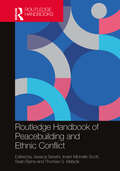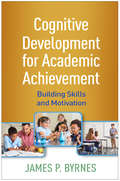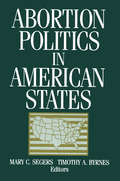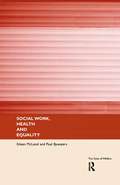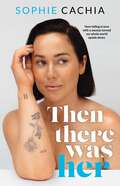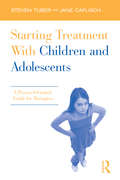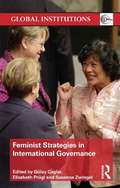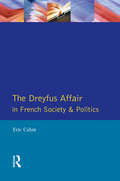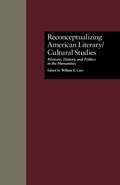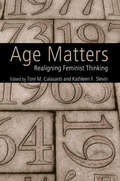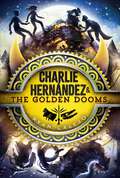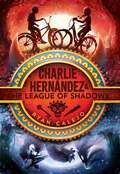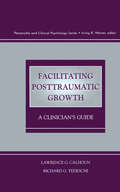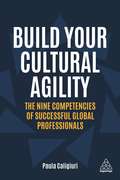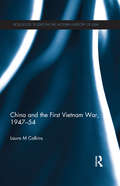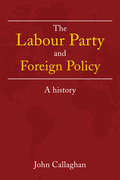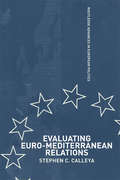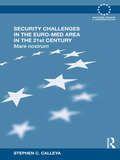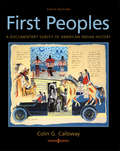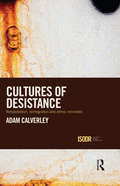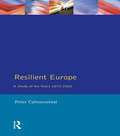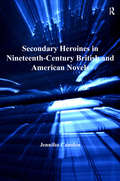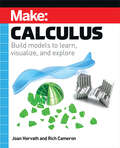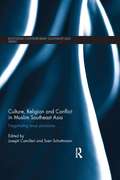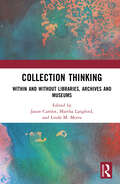Special Collections
Benetech’s Global Certified Accessible Titles
Description: Benetech’s GCA program is the first independent third-party EPUB certification to verify ebook accessibility. By creating content that is born accessible, publishers can meet the needs of all readers. Learn more: https://bornaccessible.benetech.org/
- Table View
- List View
Routledge Handbook of Peacebuilding and Ethnic Conflict
by Sean Byrne and Imani Michelle Scott and Jessica Senehi and Thomas G. MatyókThis handbook offers a comprehensive analysis of peacebuilding in ethnic conflicts, with attention to theory, peacebuilder roles, making sense of the past and shaping the future, as well as case studies and approaches. Comprising 28 chapters that present key insights on peacebuilding in ethnic conflicts, the volume has implications for teaching and training, as well as for practice and policy. The handbook is divided into four thematic parts. Part 1 focuses on critical dimensions of ethnic conflicts, including root causes, gender, external involvements, emancipatory peacebuilding, hatred as a public health issue, environmental issues, American nationalism, and the impact of the COVID-19 pandemic. Part 2 focuses on peacebuilders’ roles, including Indigenous peacemaking, nonviolent accompaniment, peace leadership in the military, interreligious peacebuilders, local women, and young people. Part 3 addresses the past and shaping of the future, including a discussion of public memory, heritage rights and monuments, refugees, trauma and memory, aggregated trauma in the African-American community, exhumations after genocide, and a healing-centered approach to conflict. Part 4 presents case studies on Sri Lanka’s postwar reconciliation process, peacebuilding in Mindanao, the transformative peace negotiation in Aceh and Bougainville, external economic aid for peacebuilding in Northern Ireland, Indigenous and local peacemaking, and a continuum of peacebuilding focal points. The handbook offers perspectives on the breadth and significance of peacebuilding work in ethnic conflicts throughout the world. This volume will be of much interest to students of peacebuilding, ethnic conflict, security studies, and international relations.
Cognitive Development for Academic Achievement
by James P. ByrnesThis integrative text spotlights what educators need to know about children's cognitive development across grade levels (PreK-12) and content areas. The book provides a concise introduction to developmental neuroscience and theories of learning. Chapters on general cognitive abilities probe such crucial questions as what children are capable of remembering at different ages, what explains differences in effort and persistence, and how intelligence and aptitudes relate to learning. Domain-specific chapters focus on the development of key academic skills in reading, writing, math, science, and history. Multiple influences on academic achievement and motivation are explored, including school, family, cultural, and socioeconomic factors. Each chapter concludes with clear implications for curriculum and instruction.
Abortion Politics in American States
by Timothy A. Byrnes and Mary C. SegersThe essays presented here draw from the Soviet Interview Project's evidence of the internal condition of the CPSU party during the "era of stagnation" and its role, influence, and impact on the operation of legal and economic institutions and state bureaucracies.
Social Work, Health and Equality
by Paul Bywaters and Eileen McLeodWhat impact can social work make on inequalities in health? Social Work, Health and Equality opens up a new direction in the practice and theory of social work. Focussing on the profound human suffering which arises from social inequalities in health, it: * shows how social work can make a significant contribution to creating more equal experiences of health and illness * describes the major shifts in conceptualisation, practice and organisation necessary to bring about change. The authors explore these questions in relation to four key aspects of health; health maintenance, illness at home, hospitalisation, and facing death. Grounding the text in everyday lived experience, they show how social work must change its discourse and its practice if it is to respond effectively to the challenges of its new role in tackling health issues.
Then There Was Her
by Sophie CachiaSocial media and business entrepreneur Sophie Cachia reveals never-before-shared details of her marriage breakdown, and how delving into her feminine intuition and falling in love with a woman turned her whole world upside down. I was running late, again. The sweat from under my milk-filled udders ran down my stomach and onto the post-natal recovery shorts I&’d squeezed on under my leather skirt. Only eight weeks earlier, I&’d birthed my second baby, and this was one of my first work appearances. I raced into the hotel, took the lift to the wrong floor, fumbled my bag and finally landed at the entrance. I went around the circle of unfamiliar faces, smiling, shaking hands, introducing myself… Then there was her. As our hands touched, time froze. My whole world changed forever… Sophie Cachia had her white picket fence life. By the age of 25, she was a mother and happily married, and had also built a very successful business by documenting her every move online. But Sophie and her comfortable existence were thrown a curveball when she met a woman who prompted her to ask herself the questions: What more can I do? What more can I learn? What more can I be? In Then There Was Her, Sophie describes how challenging the set social narrative for a young woman led her down a path of awareness, empowerment and acceptance as she navigated identity, sensuality and the true meaning of authenticity as a mother and a woman. A deeply honest and inspirational memoir of a strong female who made peace with her decisions all in the unrelenting glare of the public eye, Then There Was Her encourages readers to stop fearing the unknown in life and to instead be excited about what may just come your way.
Starting Treatment With Children and Adolescents
by Steven Tuber and Jane CaflischStarting Treatment With Children and Adolescents provides therapists with a time-tested framework for treatment and a moment-by-moment guide to the first few sessions with a new patient. In twelve remarkable case studies, verbatim transcripts of individual play-therapy sessions are brought to life through running commentary on techniques and theory and a fine-grained analysis of what worked, what didn’t, and what else the clinician could have done to make the session as productive as possible. Clinicians will come away from the book with a unique window into how other therapists actually work as well as new tools for engaging children and adolescents in process-oriented treatment. They’ll also be guided through an exploration of common questions such as how else could I have handled that situation? What other paths could I have tried? Where might those other paths have led? What treatment strategies are most advantageous to my patients’ growth – and to my own?
Feminist Strategies in International Governance
by Susanne Zwingel and Gülay Caglar and Elisabeth PrüglThe struggle for women’s rights and to overcome gender oppression has long engaged the efforts of inter-governmental and non-governmental organizations. Feminist Strategies in International Governance provides a new introduction to the contemporary forms of this struggle. It brings together the voices of academics and practitioners to reflect in particular on the effectiveness of human rights strategies and gender mainstreaming. It covers three international issue areas in which feminists currently seek change: women’s human rights and violence against women; the participation of women in peace-making and their protection during conflict; and the gendered effects of development, economic and financial governance. The book combines a critical reflection on the current state of feminist politics with an introduction to urgent issues on the contemporary international agenda. In addition, the book draws on innovative conceptualizations from constructivism in international relations, legal anthropology and discourse theory to provide new framings of current feminist struggles. Offering an accessible guide to the engendering of international governance and examining the challenges for international feminist politics in the future, this work will be of great interest to students and scholars of international organizations, gender politics and global governance.
The Dreyfus Affair in French Society and Politics
by Eric CahmThe Dreyfus affair remains one of the most famous miscarriages of justice in modern times. Eric Cahm's study does justice to the human drama, whilst also throwing light on the wider society and politics of the Third Republic in the traumatic years after the Franco-Prussian War. This wide-ranging survey - the only short modern account in English anchors the Affair in its full social and political context. Organised round a narrative of events, it offers portraits of all the main characters, substantial extracts from key sources in fresh translations, a comprehensive bibliography and a detailed chronology.
Reconceptualizing American Literary/Cultural Studies
by William E. CainFirst published in 1996. Routledge is an imprint of Taylor & Francis, an informa company.
Age Matters
by Toni M. Calasanti and Kathleen F. SlevinThis volume of original chapters is designed to bring attention to a neglected area of feminist scholarship - aging. After several decades of feminist studies we are now well informed of the complex ways that gender shapes the lives of women and men. Similarly, we know more about how gendered power relations interface with race and ethnicity, class and sexual orientation. Serious theorizing of old age and age relations to gender represents the next frontier of feminist scholarship. In this volume, leading national and international feminist scholars of aging take first steps in this direction, illuminating how age relations interact with other social inequalities, particularly gender. In doing so, the authors challenge and transform feminist scholarship and many taken for granted concepts in gender studies.
Charlie Hernández & the Golden Dooms
by Ryan CalejoInspired by Latinx folklore, legends, and myths from the Iberian Peninsula and Central and South America, this &“clever, funny, and entertaining&” (Kirkus Reviews) third book in the Charlie Hernández series follows Charlie as he faces off against an army of the dead.After hitchhiking across Central and South America to rescue the Witch Queen and face off against La Mano Peluda, Charlie Hernández is pretty much grounded for life. But after all he&’s been through, some quiet time at home with his parents might be nice. Though it would be better if he didn&’t have to share his room with his obnoxiously perfect cousin Raúl, who&’s staying with them. But quiet is hard to come by when you&’re the fifth and final morphling, and it&’s not long before death walks back into Charlie&’s life. Or at least, the dead do, starting with a mysterious young calaca who corners him at school, dropping cryptic hints about trouble brewing in the 305. With the League of Shadows focused on repairing fractured alliances and tracking gathering armies, this one&’s up to Charlie to solve. Following the clues only leads to more questions, and not even teenage investigative journalist extraordinaire Violet Rey can figure out how a sudden rooster infestation, earthquakes, missing persons, and a pet-napping gang of lizard-men—whom Charlie doesn&’t recognize from any legend—are all connected. Most concerning of all is when they learn a map has been stolen that reveals the locations of the Golden Dooms, the twelve ancient calaca watchmen who form the magical barrier between the realms. To stop the impending invasion, Charlie and Violet must outwit an ancient evil and unravel the most sinister of schemes. That is, unless they&’d rather watch the Land of the Living get overrun by the dead.
Charlie Hernández & the League of Shadows
by Ryan Calejo&“A perfect pick for kids who love Rick Riordan.&” —Booklist (starred review) &“A winner for all kids, but it will be especially loved by Latinx and Hispanic families.&” —Kirkus Reviews (starred review) The Lightning Thief meets the Story Thieves series in this middle grade fantasy inspired by Hispanic folklore, legends, and myths from the Iberian Peninsula and Central and South America.Charlie Hernández has always been proud of his Latin American heritage. He loves the culture, the art, and especially the myths. Thanks to his abuela&’s stories, Charlie possesses an almost encyclopedic knowledge of the monsters and ghouls who have spent the last five hundred years haunting the imaginations of children all across the Iberian Peninsula, as well as Central and South America. And even though his grandmother sometimes hinted that the tales might be more than mere myth, Charlie&’s always been a pragmatist. Even barely out of diapers, he knew the stories were just make-believe—nothing more than intricately woven fables meant to keep little kids from misbehaving. But when Charlie begins to experience freaky bodily manifestations—ones all too similar to those described by his grandma in his favorite legend—he is suddenly swept up in a world where the mythical beings he&’s spent his entire life hearing about seem to be walking straight out of the pages of Hispanic folklore and into his life. And even stranger, they seem to know more about him than he knows about himself. Soon, Charlie finds himself in the middle of an ancient battle between La Liga, a secret society of legendary mythological beings sworn to protect the Land of the Living, and La Mano Peluda (a.k.a. the Hairy Hand), a cabal of evil spirits determined to rule mankind. With only the help of his lifelong crush, Violet Rey, and his grandmother&’s stories to guide him, Charlie must navigate a world where monsters and brujas rule and things he couldn&’t possibly imagine go bump in the night. That is, if he has any hope of discovering what&’s happening to him and saving his missing parents (oh, and maybe even the world). No pressure, muchacho.
Facilitating Posttraumatic Growth
by Lawrence G. Calhoun and Richard G. TedeschiIn this book, Calhoun and Tedeschi construct the first systematic framework for clinical efforts to enhance the processes they sum up as posttraumatic growth. Posttraumatic growth is the phenomenon of positive change through struggle with even the most horrible sets of circumstances. People who experience it tend to describe three general types of change: realistically stronger feelings of vulnerability that are nonetheless accompanied by stronger feelings of personal resilience, closer and deeper relationships with others, and a stronger sense of spirituality. Posttraumatic growth has only recently become an important focus of interest for researchers and practitioners. Drawing on a burgeoning professional literature as well as on their own extensive clinical experience, the authors present strategies for helping clients effect all three types of positive change--strategies that have been tested in a variety of groups facing a variety of crises and traumas. Their concise yet comprehensive practical guide will be welcomed by all those who counsel persons grappling with the worst life has to offer.
Build Your Cultural Agility
by Paula CaligiuriThe investment in global collaboration technology now exceeds US$45 billion. Professionals who work across cultures face some of the most cognitively, psychologically and emotionally difficult challenges, regardless of whether they work virtually or in person. And they often face these challenges without the help of a corporate guide. Build Your Cultural Agility is that guide. This book offers strategies to help you develop into a successful global professional, one who can comfortably and effectively work in and with people from different cultures. This book helps you leverage your natural strengths while providing suggestions for developing cultural agility competencies. Build Your Cultural Agility focuses on nine specific competencies that comprise cultural agility: three self-management competencies (tolerance of ambiguity, curiosity and resilience), three relationship-management competencies (humility, relationship-building and perspective-taking) and three task-management competencies (cultural minimization, cultural adaptation and cultural integration). Within each chapter, the author provides a case example of that competency in action, explains why the competency is critical for success, offers a self-awareness exercise to help you determine your level of proficiency and concludes with suggestions for self-development.
China and the First Vietnam War, 1947-54
by Laura M. CalkinsThis book charts the development of the First Vietnam War – the war between the Vietnamese Communists (the Viet Minh) and the French colonial power – considering especially how relations between the Viet Minh and the Chinese Communists had a profound impact on the course of the war. It shows how the Chinese provided finance, training and weapons to the Viet Minh, but how differences about strategy emerged, particularly when China became involved in the Korean War and the subsequent peace negotiations, when the need to placate the United States and to prevent US military involvement in Southeast Asia became a key concern for the Chinese. The book shows how the Viet Minh strategy of all-out war in the north and limited guerrilla warfare in the south developed from this situation, and how the war then unfolded.
The Labour Party and Foreign Policy
by John CallaghanThis book provides a penetrating new study of the Labour Party’s thinking on international relations, which probes the past, present and future of the party’s approach to the international stage. The foreign policy of the Labour Party is not only neglected in most histories of the party, it is also often considered in isolation from the party’s origins, evolution and major domestic preoccupations. Yet nothing has been more divisive and more controversial in Labour’s history than the party’s foreign and defence policies and their relationship to its domestic programme. Much more has turned on this than the generation of tempestuous conference debates. Labour’s credentials as a credible prospect for Governmental office were thought to depend on a responsible approach to foreign and defence policy. Its exclusion from office was often said to stem from a failure to meet this test, as in the 1950s. The composition of Labour Cabinets was powerfully influenced by foreign and defence considerations, as was the centralization of power and decision-making within Labour Governments. The domestic achievements and failures of these periods in office were inextricably connected to international questions. The Labour Party and Foreign Policy is recommended for undergraduate and postgraduate courses in British politics and European history.
Evaluating Euro-Mediterranean
by Stephen CalleyaFirst Published in 2004. Routledge is an imprint of Taylor & Francis, an informa company.
Security Challenges in the Euro-Med Area in the 21st Century
by Stephen CalleyaThis book examines and assesses the main security factors influencing Euro-Mediterranean relations at the start of the twenty-first century. Developing a theoretical framework based on the security complex, this book provides an empirical analysis of security challenges in the Euro-Mediterranean area that distinguishes between short, medium and long-term threats and highlights the political, military, economic, societal and environmental issues that are already serving as a source of instability in the region. Including analysis of the 2011 Arab Spring, the author examines the consequences and looks to the future of security in the Euro-Mediterranean region. Acknowledging the strategic significance of this region between Europe and the Middle East, the book identifies the main stakeholders within today’s debate on the future of Euro-Mediterranean relations and focuses on their main security interests in this region. It features a policy analysis of the main actors in the Mediterranean, including NATO, the United States, and the European Union and addresses issues including illegal migration, terrorism, religious intolerance and the lack of human rights Security Challenges in the Euro-Med Area in the 21st Century be of interest to students and scholars of European Politics, Security Studies and International Relations.
Cultures of Desistance
by Adam CalverleyIn contrast to the widespread focus on ethnicity in relation to engagement in offending, the question of whether or not processes associated with desistance – that is the cessation and curtailment of offending behaviour – vary by ethnicity has received less attention. This is despite known ethnic differences in factors identified as affecting disengagement from offending, such as employment, place of residence, religious affiliation and family structure, providing good reasons for believing differences would exist. This book seeks to address this oversight. Using data obtained from in-depth qualitative interviews it investigates the processes associated with desistance from crime among offenders drawn from some of the principal minority ethnic groups in the United Kingdom. Cultures of Desistance explores how structural (families, friends, peer groups, employment, social capital) and cultural (religion, values, recognition) ethnic differences affected the environment in which their desistance took place. For Indians and Bangladeshis, desistance was characterised as a collective experience involving their families actively intervening in their lives. In contrast, Black and dual heritage offenders’ desistance was a much more individualistic endeavour. The book suggests a need for a research agenda and justice policy that are sensitive to desisters’ structural location, and for a wider culture which promotes and supports desisters’ efforts.
Resilient Europe
by Peter CalvocoressiFirst published in 1992. Routledge is an imprint of Taylor & Francis, an informa company.
Secondary Heroines in Nineteenth-Century British and American Novels
by Jennifer CamdenTaking up works by Samuel Richardson, James Fenimore Cooper, Sir Walter Scott, and Catharine Maria Sedgwick, among others, Jennifer B. Camden examines the role of female characters who, while embodying the qualities associated with heroines, fail to achieve this status in the story. These "secondary heroines," often the friend or sister of the primary heroine, typically disappear from the action of the novel as the courtship plot progresses, only to return near the conclusion of the action with renewed demands on the reader's attention. Accounting for this persistent pattern, Camden suggests, reveals the cultural work performed by these unusual figures in the early history of the novel. Because she is often a far more vivid character than the heroine of the marriage plot, the secondary heroine inevitably engages the reader's interest in her plight. That the narrative apparently seeks to suppress her creates tension and points to the secondary heroine as a site of contested identity who represents an ideology of womanhood and nationhood at odds with the national ideals represented by the primary heroine, whom the reader is asked to embrace. In showing how the anxiety produced by these ideals is displaced onto the secondary heroine, Camden's study represents an important intervention into the ways in which early novels use character to further ideologies of race, class, sex, and gender.
Make: Calculus
by Joan Horvath and Rich CameronWhen Isaac Newton developed calculus in the 1600s, he was trying to tie together math and physics in an intuitive, geometrical way. But over time math and physics teaching became heavily weighted toward algebra, and less toward geometrical problem solving. However, many practicing mathematicians and physicists will get their intuition geometrically first and do the algebra later.Make:Calculus imagines how Newton might have used 3D printed models, construction toys, programming, craft materials, and an Arduino or two to teach calculus concepts in an intuitive way. The book uses as little reliance on algebra as possible while still retaining enough to allow comparison with a traditional curriculum.This book is not a traditional Calculus I textbook. Rather, it will take the reader on a tour of key concepts in calculus that lend themselves to hands-on projects. This book also defines terms and common symbols for them so that self-learners can learn more on their own.
Culture, Religion and Conflict in Muslim Southeast Asia
by Joseph Camilleri and Sven SchottmannBy examining the sometimes surprising and unexpected roles that culture and religion have played in mitigating or exacerbating conflicts, this book explores the cultural repertoires from which Southeast Asian political actors have drawn to negotiate the pluralism that has so long been characteristic of the region. Focusing on the dynamics of identity politics and the range of responses to the socio-political challenges of religious and ethnic pluralism, the authors assembled in this book illuminate the principal regional discourses that attempt to make sense of conflict and tensions. They examine local notions of "dialogue," "reconciliation," "civility" and "conflict resolution" and show how varying interpretations of these terms have informed the responses of different social actors across Southeast Asia to the challenges of conflict, culture and religion. The book demonstrates how stumbling blocks to dialogue and reconciliation can and have been overcome in different parts of Southeast Asia and identifies a range of actors who might be well placed to make useful contributions, propose remedies, and initiate action towards negotiating the region’s pluralism. This book provides a much needed regional and comparative analysis that makes a significant contribution to a better understanding of the interfaces between region and politics in Southeast Asia.
Collection Thinking
by Linda M. Morra and Jason Camlot and Martha LangfordCollection Thinking is a volume of essays that thinks across and beyond critical frameworks from library, archival, and museum studies to understand the meaning of "collection" as an entity and as an act. It offers new models for understanding how collections have been imagined and defined, assembled, created, and used as cultural phenomena. Featuring over 70 illustrations and 21 original chapters that explore cases from a wide range of fields, including library and archival studies, literary studies, art history, media studies, sound studies, folklore studies, game studies, and education, Collection Thinking builds on the important scholarly works produced on the topic of the archive over the past two decades and contributes to ongoing debates on the historical status of memory institutions. The volume illustrates how the concept of "collection" bridges these institutional and structural categories, and generates discussions of cultural activities involving artifactual arrangement, preservation, curation, and circulation in both the private and the public spheres. Edited and introduced collaboratively by three senior scholars with expertise in the fields of literature, art history, archives, and museums, Collection Thinking is designed to stimulate interdisciplinary reflection and conversation. This book will be of interest to scholars and practitioners interested in how we organize materials for research across disciplines of the humanities and social sciences. With case studies that range from collecting Barbie dolls to medieval embroideries, and with contributions from practitioners on record collecting, the creation of sub-culture archives, and collection as artistic practice, this volume will appeal to anyone who has ever wondered about why and how collections are made.
